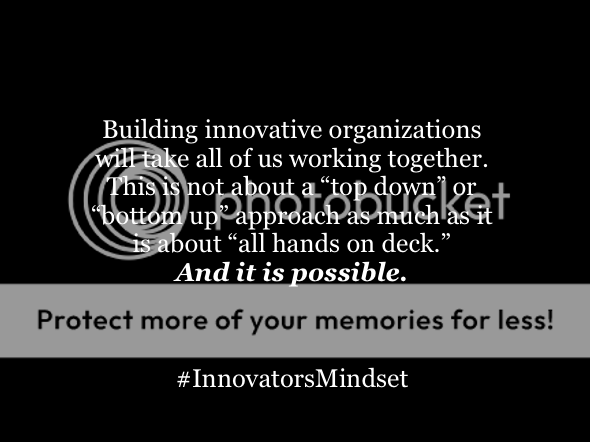4 Ways to Lead and Create a "Culture of Innovation" From Any Position

Leadership can happen from any position. We know this. But what is the impact when we focus on viewing leadership this way and ensuring that every member of the school community has ownership on the direction moving forward?
This is why this question is crucial; how do we move from “pockets” of innovation, to a “culture” of innovation?7 We all believe there are forward thinking classrooms really pushing the boundaries of what learning can look like in schools, but are they the norm or the exception?
There have been many educators, from whatever position they are in, that have a profound impact on the learning that happens in their schools, outside of their own classrooms. I would feel uncomfortable hiring someone to their first “administration” position, if they have never been a “leader”. Influence to help people move forward, can happen from anywhere and anyone.
But for this type of leadership to happen (and flourish) from any position, we have to think differently about what we do, and how we do it.
Here are a few things that can help move schools forward to a “culture” of innovation, no matter what position you are in.
- We need to be accountable to each other, not just administrators. There is expertise in all buildings, and the notion of “you can’t be a prophet in your own land”, is one that we need to retire. Think about this truly; would you be excited to learn in some of the classrooms in your school? If not, what are you doing about it? Are you having conversations with your colleagues? Sharing ideas that can help all of us get better? If we expect everyone to be accountable to the principal or superintendent only, change will take forever.1 We need to push and support each other to become better. This leads into the next point.
- We have to promote and model challenging conversations. Challenging ideas in education is crucial, but we have to be thoughtful of doing it in a respectful manner. In my workshops, I encourage people to challenge my ideas, understanding that the focus in on, “What is best for kids?” How we ask questions is crucial though. Are our questions statements in disguise, or are they genuinely focused on asking questions to move forward, not simply to hold on. Many educators embrace the notion that the best learning can happen when we are uncomfortable, and this should be no different in the conversations we have with our colleagues. Just be sure that people feel valued before you challenge them, or this could backfire.
- We need to constantly look at our own environments, with fresh eyes. You may have been in your school for several years, and the concern about this is that we become numb to our environment. As someone who speaks in schools quite often, I look at everything that is on the walls when I walk in, and observe the feeling of welcoming when I walk into classrooms. One school I walked into had extremely old artwork that was deteriorating in the hallway, and then later talked to me about how some kids are disrespectful in school. I saw a connection between the environment in the school and how the kids felt when they were there. If we become numb to what we do, what we see, and what we hear, we have a hard time moving forward. Observe, look, challenge, and wonder about the things on the walls and the learning in the school like it was your first day, every day. For some people that walk into your schools, it will be their first day.2
- Focus on being a “school” teacher, not simply a “classroom teacher”. Simply put a “classroom” teacher, is focused mostly on the success of the students that teach this year; a “school” teacher is focused on the success of all kids within the school (or even district). They see things like supervision as an opportunity to connect with students they don’t usually teach, but also they are more willing to open their classroom to colleagues because they know that what they are doing, can have an impact on other kids. Would there not be a significant increase in the environment of schools if each individual took ownership over the success of the community as a whole? Impact one other teacher in your school, and you impact probably a minimum of twenty students (that year only). When it is “our school”, the influence we have on one another, is more powerful than the influence of one administrator.
As I stated in “The Innovator’s Mindset“,
Building innovative organizations will take all of us working together. This is not about a “top down” or “bottom up” approach as much as it is about “all hands on deck.” And it is possible.
Creating a “culture of innovation”, where powerful and deep learning is the norm, not the exception, will more likely happen if we count on the leadership of all, not the leadership of “one."
Source: George Couros
Want to bring George to your next event? Let us know here. We'd love to help make it happen!










